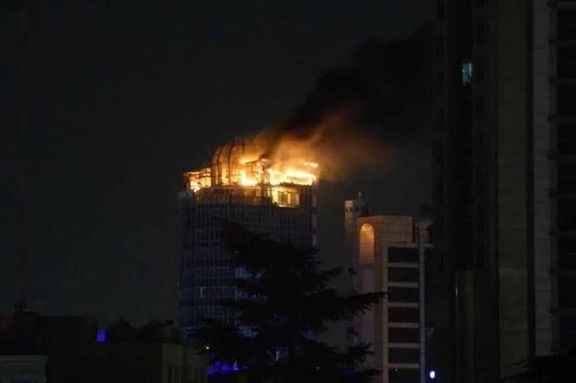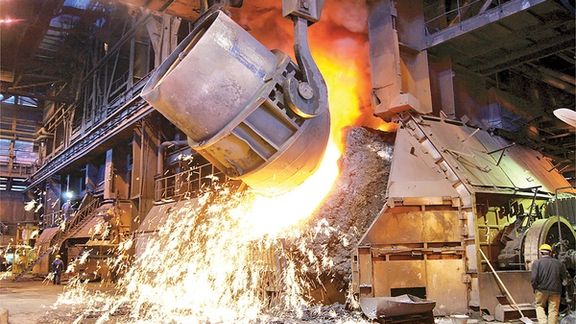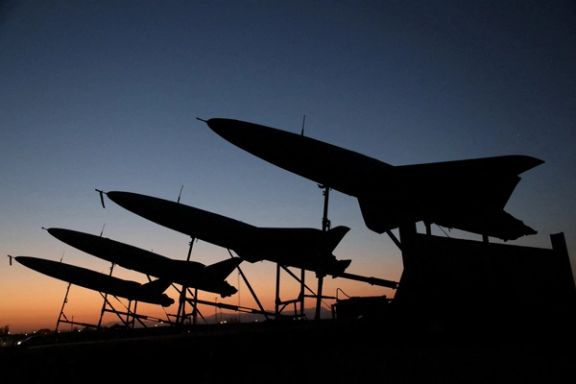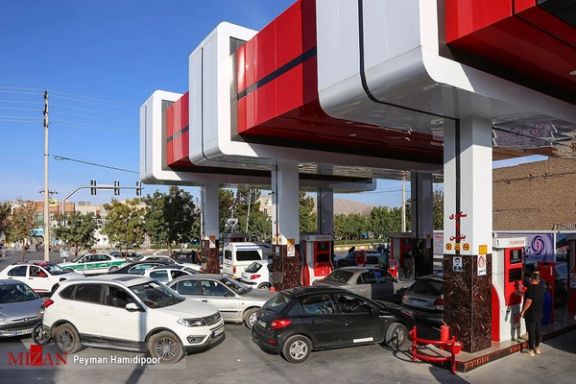Three Firefighters Injured In West Tehran Commercial Building Fire

Three firefighters have sustained injuries whilst extinguishing a commercial building fire in Karaj, west of Tehran, that broke out Thursday night.

Three firefighters have sustained injuries whilst extinguishing a commercial building fire in Karaj, west of Tehran, that broke out Thursday night.
The incident at Taleghani Tower was successfully brought under control by the firefighting team, local authorities announced.
Mehdi Samiei, the spokesperson for the Fire and Safety Services of Karaj Municipality said, "The fire originated on the 16th floor of a commercial complex, and through the efforts of firefighting teams, it was extinguished."
"Unfortunately, three firefighters sustained injuries during the firefighting operation," he added. Samiei also disclosed that an investigative team is onsite, scrutinizing the circumstances that led to the incident.
Furthermore, he highlighted the scale of the response, stating, "A total of fifty personnel, complemented by fifteen emergency vehicles from twelve stations, were dispatched to the scene to engage in firefighting and rescue operations."
Although hundreds of buildings in Tehran are at high-risk of fire, authorities are withholding the list of endangered buildings to avoid public concern.
In January 2017, the Plasco Building's fire caused its 20-story collapse, claiming 20 firefighter lives and injuring 70 more.

Amid the ongoing power shortage crisis in Iran, Khuzestan Steel Company has been forced to halt operations and put workers on mandatory furloughs.
According to information obtained by Iran International the shutdown of Iran’s second biggest steel producer started a week ago following several weeks of reduced operations due to persistent electricity outages.
According to an informed source, each day of the shutdown results in a substantial loss of around $15 million. Khuzestan Steel Company is in southwestern Iran near Ahvaz, the provincial capital of oil-rich Khuzestan province, whose residents are grappling with regular power outages in the midst of one of the worst heatwaves in recent history.
The company's CEO Amin Ebrahimi told IRGC-affiliated Fars news agency Thursday that the plant is undergoing regular repair and maintenance at the moment, but he did not confirm the shutdown. He cited the Energy Ministry as announcing a 29% increase in electricity supply to steel plants, claiming that this will result in a boost in production.
Earlier in the year, reports by industry sources revealed that steel production in Iran had plummeted because the country faced a severe shortage of electricity and gas, both vital for running the plants. Iranian industrialist Reza Shahrestani said In January the steel industry needed 40 million cubic meters of gas daily, but their consumption was at 15 million cubic meters per day at the time. He added that almost 50% of the electricity supply for industries has been cut off too.
The World Steel Association, in its March report, removed Iran from the list of the 10 largest steel producers in the world. Iran has always been among the top 10 in the world, and in the first two months of 2023, Iran was the ninth largest steel producer ahead Turkey.
Economist Ahmad Alavi told Iran International that the total loss from the shutdown of Khuzestan Steel Company is not limited to the estimated $15-million because there are a lot of other businesses in different sectors that depend on the steel industry and will suffer losses. He added that the poor infrastructure in the steel industry – as well as other industries – is a result of decades of mismanagement and lack of investment, therefore the regime will not be able to resolve these issues in the near future.

Germany-based journalist Ata Hosseinian told Iran International that the shutdown is only one of the many consequences of the disparity between power generation and consumption. He added that now the power shortage in the country is not only impeding small businesses or plants but also damaging key industries.
In early August, Iran implemented a two-day shutdown of businesses and factories nationwide, initially presented as a health safety measure. However, it was later revealed that it was an excuse to deflect attention from the ongoing electricity, gas, and water shortages.
Payam-e Ma newspaper cited an informed yet unnamed source from the Energy Ministry as saying that the reason behind the shutdown was the country's electricity shortages. The constant rise in temperatures and decrease in rainfall across the country in the last decade have made electricity supply a challenge during peak consumption periods that happen in summers and winters. In July, Iran’s electricity usage hit a record of 72,500 megawatts, increasing the strain on power grids that were already struggling to meet demand.
"High temperature and increased electricity consumption in the past days have led the hydroelectric power plants of Karun-3 and Karun-4 dams – on the Iranian river with the highest water flow -- to produce electricity beyond their nominal capacity," the daily said. The power plants were reportedly generating electricity for more than 20 hours per day in the past several days, leading to a "depletion of water resources," which caused the plants to "temporarily cease production."
Power plant capacity and fuel supply are both inadequate to meet demand, and blackouts regularly happen in summer. Even so, Iran exports electricity to Iraq. Iran's electricity grid is overstretched and has failed to realize its annual growth plan for several years in a row, while consumption continues to grow, in part driven by extremely low prices. It is in dire need of significant investment and technological upgrade, which have been hindered for years by sanctions imposed because of Iran’s nuclear and missile programs.
Iranian environmentalist Kaveh Madani -- the former deputy head of Iran's department of environment who heads the United Nations University Institute for Water, Environment and Health, posted on X on Wednesday, stating that Iran’s bankruptcy of water, electricity, and gas cannot be solved by simply shutting down the country.

Russia is making significant strides in the mass production of an Iranian-designed attack drone, capable of targeting Ukrainian urban areas from over 1,000 miles away.
According to a report in the Washington Post, leaked documents from an insider within the Russian Republic of Tatarstan's Alabuga Special Economic Zone, indicate that, despite delays and a production process that affected by sanctions affecting essential components, Moscow has made steady progress toward its goal of manufacturing the Iranian Shahed-136, an attack drone capable of traveling more than 1,000 miles.
The source, opposing Russia's military involvement in Ukraine, also shed light on the complexity of the situation. Iran acknowledges supplying drones to Russia but insists these transactions occurred prior to Russia's February 2022 invasion of Ukraine.
While Russia had initially denied deploying Iranian drones in Ukraine, President Vladimir Putin supports expanding domestic drone production, envisioning an industry value exceeding $20 billion. Russian officials are yet to respond to the Washington Post's findings.
The report also asserts that Russia has built an autonomous drone production facility in the Tatarstan region, 500 miles east of Moscow, with plans to manufacture around 6,000 drones by mid-2025. Engineers at the facility are working on enhancing the Iranian drone's design, aiming for larger-scale production and improved quality. They are also exploring capabilities for coordinated "swarm attacks." Spanning from winter 2022 to spring 2023, the documents encompass blueprints, schematics, and crucial details, some of which were previously reported by the Russian news outlet Protokol.
In response, Washington has imposed sanctions on Russia and Iran, targeting key figures within a defense firm associated with drone supply to Russia. Several entities and individuals engaged in drone-related activities are also subject to sanctions.

Shortage of gasoline across Iran has prompted widespread concern and panic buying, leading to congestion at numerous gas stations across Iran.
Over the past two days, long queues formed at gas stations in the southern city of Shiraz over fears of price hikes and deficit in supply.
The government continues to deny the shortage, saying that people are reacting to "rumors” with the Minister of Oil insisting there is an adequate gasoline supply nationwide.
However, local officials and members of parliament are concerned. Ruhollah Nejabat, Shiraz’s representative in parliament, stated, "In Shiraz, gasoline has not been adequately supplied to the people for two days, despite the Minister's claims to the contrary."
Long queues of vehicles formed at gas stations across the country on Wednesday, despite assurances from regime officials that prices would not increase, and the country's fuel tanks “remained full”.
A video released by the IRGC-affiliated Tasnim News Agency highlighted the severity of the situation, showing a queue of vehicles at a gas station in Karaj, west of Tehran, stretching over a kilometer.
Iran's Minister of Oil responded saying that fuel station cards are intended for emergency situations and that the lines forming at gas stations are a result of increased travel.
The current situation harks back to November 2019 when a sudden increase in gasoline prices sparked widespread protests, leading to anti-government sentiments and a strong response from security forces.

Iran’s ruler Ali Khamenei has praised the Revolutionary Guard while their loyalty and power to quash dissent will be put to test once again during possible protests.
In a meeting with a group of senior IRGC officers and Basij paramilitary leaders on Thursday, Khamenei described the Revolutionary Guard as “the largest counter-terrorist organization in the world,” while international calls to designate the group as a terrorist outfit have been echoing across the political landscape of many countries.
Reacting to Khamenei’s flattering words, hundreds of Iranians rushed to social media to point out that the statement is accurate as long as the prefix “counter or anti” is removed from the word terrorist.
Washington designated the IRGC as a foreign terrorist group in 2019 and US lawmakers have made repeated calls to their allies to prioritize designating the group as such. In May, a bipartisan group of US congresspeople sent letters to the heads of US-allied nations -- the UK, Australia, Canada, and India – to reiterate calls to swiftly act and officially sanction the IRGC in its entirety.
Despite numerous pleas by politicians, diplomats, opposition leaders and activists, the UK and EU are still hesitant to proscribe the entity, which has proved to be the most destabilizing element in the Middle East region and a big threat to American and European citizens in the world, as well as the main suppression force in Iran.

During the meeting with his most important base of support, Khamenei warned of attempts to besmirch the IRGC and Basij forces, saying, "One of the important aspects of the enemy's activities is tarnishing the image of the IRGC. and the Basij; why? Because the Guard is awe-inspiring, the Basij is impressive, which makes them worried and anxious."
Elsewhere in his remarks, Khamenei emphasized that the US is the main enemy of the regime, saying that one of the past mistakes was not recognizing the US as ‘the enemy.’ “We must raise our voice against America,” he said.
The blandishment by the Supreme Leader came as many Iranians are planning to hold anti-regime protests to mark the anniversary of the Women, Life, Liberty movement, Iran’s biggest popular uprising sparked by the death in custody of 22-year-old Mahsa Amini in mid-September.
Khamenei depends on the IRGC and Basij to defend the main bastion of the regime as he cannot trust the traditional Army, which has been kept weak. However, minutes of a meeting of senior clerics and IRGC commanders with Khamenei, leaked to the media in March, indicated the negative impact of the protests on the morale of forces under the command of the IRGC and their burn-out, with several offering anecdotal accounts of insubordination.
“It is a well-equipped military organization. It is an efficient and independent organization capable of carrying out tasks that many of the world's major militaries cannot accomplish,” Khamenei stated during the Thursday meeting with the Supreme Assembly of Commanders of the IRGC.

IRGC’s extraterritorial Quds force leads activities of regime’s proxy forces against the United States, Israel, and other adversaries in the region and beyond. The IRGC is providing drones and missiles for the Russian invasion of Ukraine, and is also involved in assassinations, kidnappings and cyberespionage operations across the globe.
The outfit is also behind drugs and arms trafficking and money-laundering and other cases of economic corruption both in Iran and abroad. The IRGC is also the main force to suppress any critical voice in Iran with its members unofficially exempt from due process in case of wrongdoing and corruption.
Over 500 Iranians have been killed by security forces, mainly consisting of the IRGC and its Basij militia, during the crackdown on the last year protests, which may resume throughout Iran in the coming weeks.
Numerous politicians across France, Germany, the UK, and other European nations are eager to push for the designation of the IRGC, asserting that it has been significantly delayed. Resolutions have also been adopted in their respective parliamentary bodies, underscoring the pressing need for the IRGC's designation. However, both UK and European governments perceive this step as a potential impediment to diplomatic engagement with the Tehran regime.

Saudi Arabia and Iran are making progress on mending ties, Iran's foreign minister said after meeting with his counterpart in Riyadh on Thursday.
The two regional heavyweights seek to overcome past hostility and regional tensions, such as rivalry in Yemen or Iran’s attempts to establish military domination in the Persian Gulf..
"Relations between Tehran and Saudi are on the right track and we are witnessing progress," Hossein Amir-Abdollahian said in a joint news conference with his Saudi counterpart Prince Faisal bin Farhan, adding that "the talks were successful".
His visit to the kingdom comes months after Prince Faisal met with Iranian officials in Tehran in June on his first trip to Iran after a China-brokered deal between the regional rivals in March to resume ties.
Under the deal, Tehran and Riyadh agreed to end a diplomatic rift and reestablish relations following years of hostility that had endangered regional stability in the Persian Gulf, as well as in Yemen, Syria and Lebanon.

Saudi Arabia broke ties with Iran in 2016 after protesters attacked its embassy in Tehran in retaliation for Riyadh's execution of a prominent Shiite cleric.
"We had good discussions over a broad range of issues during our meetings today," Amir-Abdollahian said.
Prince Faisal said the kingdom hoped to see Iran's President Ebrahim Raisi visit the kingdom following King Salman bin Abdulaziz's invitation, which he had communicated during the June visit. Raisi has said he would travel to the kingdom at the "appropriate time".
Prince Faisal said the kingdom was keen to follow through with all main points of the China-brokered deal whether economic or political, adding the countries' ambassadors will start in their positions in their respective embassies after their reopening.
In June, Iran officially reopened its embassy in Saudi Arabia and Iranian state media reported earlier this month that the kingdom's embassy in Tehran had resumed operations.
"We look forward to a new phase in our relationship based on our Islamic brotherhood and work towards common interests," Prince Faisal said, adding that he welcomed Iran's endorsement of Riyadh's bid to host Expo 2030.
The United States has been engaged in an effort to normalize ties between Saudi Arabia and Israel and expand the Abraham Accords launched under the Trump administration in 2020, when the United Arab Emirates and Bahrain, close Saudi allies, established ties with Israel.
Iran, suffering from a serious economic crisis and isolation, has opted to release US hostages it has detained for years in exchange for Washington agreeing to free its frozen assets from Iraq and South Korea. Many observers believe that unblocking the assets goes further than a prisoner exchange deal and might be aimed at an informal arrangement whereby Iran refrains from escalating its nuclear program.
Reporting by Reuters